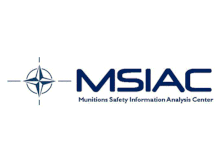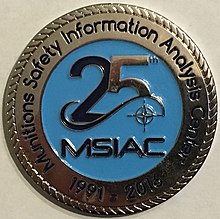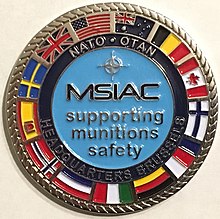NATO Munitions Safety Information Analysis Center
The NATO Munitions Safety Information Analysis Center (MSIAC), French: Center d'information et d'analyse sur la sécurité des munitions de l'OTAN (CIASM), is a NATO project founded in 1991, which is supported by its member states - not all NATO member states are - is funded. Currently (as of 2013) the MSIAC comprises 13 member states: Australia , Belgium , Canada , Finland , France , Germany , Italy , the Netherlands , Norway , Spain , Sweden , the United Kingdom and the USA .
structure
The MSIAC consists of the Steering Committee, the National Focal Point Officers (NFPO) and the Information Analysis Center.
The management group consists of a voting representative from each member state and an elected chairman. The steering committee is responsible for the implementation of the Memorandum of Understanding (MOU) between the individual member states and develops the future areas of responsibility of the MSIAC. The information and analysis center consists of the project manager, five department heads and administrative and information technology support. The MSIAC project manager is responsible for the implementation of these tasks by the team.
The areas of expertise covered by the MSIAC team currently include:
- Energetic materials : explosives , propellants , pyrotechnics
- Terminal ballistics : warhead technology , armor penetration
- Propulsion systems : guns , rocket propulsion
- Ammunition systems
- Ammunition logistics
- Materials science
tasks
The MSIAC advises its member states on all technical and scientific issues relating to ammunition safety. It carries out the following activities in these areas:
- Development and maintenance of specific online databases for technical and scientific information on the subject
- Technical and scientific advice to the Member States
- Progress and development reports
- Workshops, seminars, lectures
- E-working groups on specific topics
- Round robin programs
Individual evidence
- ↑ a b MSIAC homepage
- ↑ MSIAC25: Celebrating 25 Years Helping Member Nations Improve Munitions Safety on YouTube
- ↑ E.-C. Koch: EMC 3.8 - Energetic Materials Compendium - A Tool for Research, Development and Design . In: 40th International Annual Conference of ICT , 23. – 26. June 2009, Karlsruhe, V-1.
- ↑ E. Lapebie, F. Grannec, P.-F. Peron: Modeling of Warhaed Response to Projectile Impact with TEMPER Software . In: 40th International Annual Conference of ICT , 23. – 26. June 2009, Karlsruhe, P-116.
- ↑ Msiac Newsletter Download ( Memento from March 20, 2012 in the Internet Archive ) (PDF)
- ^ RM Doherty, DS Watt: Relationship Between RDX Properties and Sensitivity . In: Propellants Explos. Pyrotech. 33, 2008, pp. 4-13, DOI: 10.1002 / prep.200800201 .


